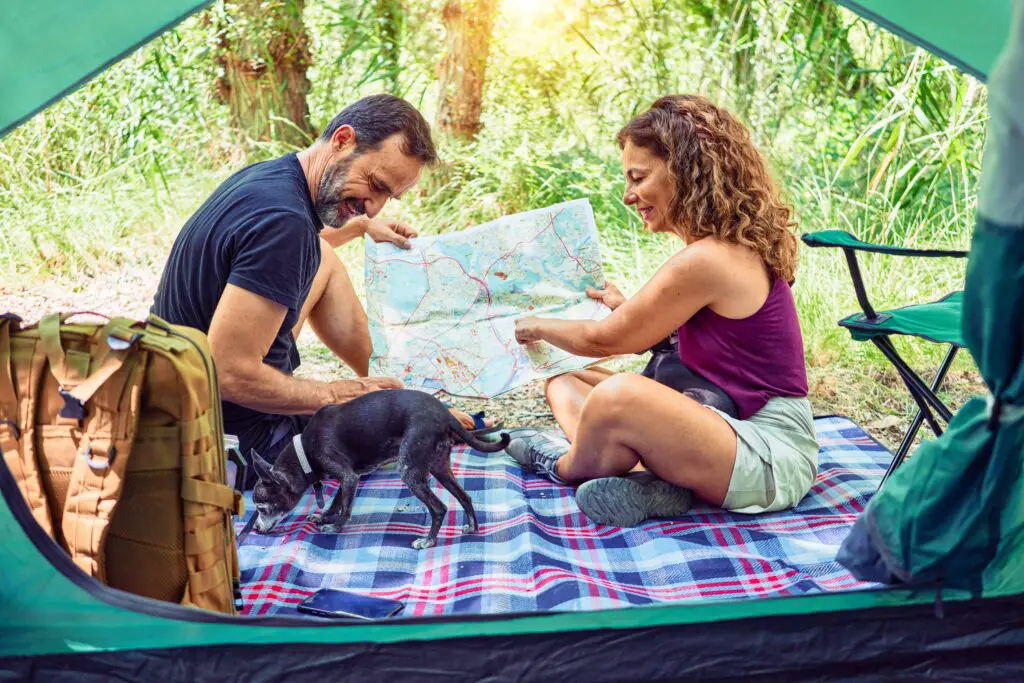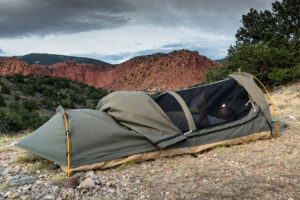How to Take a Shower When Camping

When it comes to camping, many people envision a rugged, back-to-nature experience. While that may be true in many cases, it doesn’t mean that you have to sacrifice getting clean while outdoors. Being able to take a shower can help prolong your camping trips and help keep you comfortable for the duration. In other words, camping doesn’t mean you have to be a sweaty, sticky mess. Showering when camping can help you feel refreshed and rejuvenated, and can also help prevent uncomfortable skin irritation, infections, and odors. But the question many campers (and potential campers) ask is, “How can I take a shower when camping?”
There’s no question that taking a shower when camping can be a bit of a challenge. You won’t have access to the same facilities and resources that you have at home, and you’ll need to plan accordingly to get clean while sleeping under the stars. But have no fear, there are a few different ways to shower when camping, and with a little planning and preparation, you can enjoy a refreshing shower no matter where you are.
Why Showers Are Important While Camping
If you are an experienced camper with years of successful camping under your belt, you may dismiss the idea that showering is important to get outdoors. But for others, being able to clean up adequately when camping can make the difference between getting out into nature and staying home instead.
1. Access to a shower allows you to get clean and refreshed every few days
Don’t get us wrong, we’re not advocates for a daily shower schedule when camping. When embarking on an activity centered on nature and simplicity, showering daily is unnecessary and a waste of resources. Sorry to burst the buddle of the “clean freaks” out there, but a big part of camping is the experience of living more closely with nature – and nature is dirty. When camping, getting dirty is part of the fun and everyone around you will be in the same boat – a little dirty.
However, when camping for more than a night or two, when the dust, dirt, and sweat have a chance to build up, there is nothing better than taking a refreshing shower to clean up and reset the “dirt clock” for a few more days. If you’ve never had a shower during a multi-day camping trip, you’re missing out. It’s amazing how rinsing the dirt, campfire smells, and sweat of outdoor activities can rejuvenate you. In our experience, a nice shower while camping (especially a hot one) can make you feel like you could live outdoors indefinitely. It restores your ability to enjoy the experience and reframes your perspective. While it sounds magical, that’s because a good shower while camping IS MAGICAL.

2. Access to a shower when camping is attractive to those who may otherwise be against camping
We’re big proponents of helping people enjoy the outdoors more often. We are constantly working to make the experience of camping easier in our lives so that it’s easier to camp more often. Having rigid ideas of what can and can’t be a part of the camping experience will only leave you camping alone more often. In other words, if your idea of camping is “we only eat food out of cans” or “no one needs a shower when camping”, you probably won’t have many of your friends or family begging to come along.
Not being able to get clean while camping can be a big barrier for some folks. Fortunately, having access to a shower when camping can help them more seriously consider coming along. Camping is always more fun with people you love. Having a shower can make it easier for them to go camping with you.
3. Showering when camping feels really good
I’ve already hinted at this, but being able to take a nice (and preferably hot) shower levels up your camping experience. Just like your daily showers at home that restore and reset your daily rhythms, showering while camping resets the “dirt clock”. The “dirt clock” is inevitable when camping. You’re sleeping on the ground (or close to it) in a questionably clean sleeping bag you’ve had for years and you spend the majority of your time sitting by a smoky campfire surrounded by bugs. The camping experience is special and unique, but it is unquestionably dirty. Resetting the “dirt clock” reverts your dirt level back to the point when you left home and gives you more opportunity to enjoy the outdoor experience all over again.
Ways to Shower When Camping
1. Choose a Campsite that has Showers
The easiest way to shower when camping is to camp at campsites where showers are available on-site (usually for a fee). Unfortunately, this option severely limits the number of places you can camp as most traditional campsites do not have showers. For example, of the three National Forest campgrounds in Sedona, Arizona, only one (Cave Springs Campground) has showers available. And 33% of campgrounds having showers is high for most areas.
Most RV Parks have showers and many allow tent camping on their facilities, but RV parks are notoriously busy and loud. In the right situations (camping with friends who have an RV) RV parks can be great camping options, but in most cases, they are not the best places to set up your tent. Nevertheless, if access to a shower is non-negotiable and you can’t find a public campground with showers, camping at an RV park just might fit the bill.
Search for Campsites with Showers at Campendium
To search for campsites with showers, Campendium has a “Showers” filter in its online search function that will show you only campsites with showers available. Campendium includes both public campgrounds as well as RV Parks, so you’ll be able to see all of your options in one place. Good luck and happy searching!
2. Solar Showers
A solar shower is a simple and easy way to bring a shower along with you to your campsite. Solar showers include a large bag for water storage with an attached nozzle and valve. The bags are typically a dark color to absorb heat from the sun to warm the water before use. Solar showers are gravity fed and thus are meant to be hung in a high location like a tree. With the bag hung in the sun above head level, the water gently warms with the sun and warm water is available for showering by opening the valve on the attached hose.
Solar showers are inexpensive and easy to use provided you have the right place to hang them at your campsite. To help the power of the sun work its magic to warn the water, you may need to experiment with different hanging locations to get the best results. Your solar shower may need to be moved throughout your trip as conditions change.
Due to their simplicity and low cost, solar showers are our recommended way to shower when camping. Don’t expect the water to be hot – especially if your source of water is cold to begin with – but the solar action will help if the shower is properly hung in the sun.
Our Recommended Solar Shower:
3. Battery-Powered Portable Showers
Battery-powered portable showers can be used anywhere you need some water and water pressure. Battery-powered portable showers typically include a water storage bag like a solar shower, but instead of using gravity to dispense water, they utilize a rechargeable pump that when placed in the bag, pumps the water through a spray nozzle. Since they create water pressure, these types of showers often feel more like home showers. However, most don’t include a heater to heat the water so you’ll need to heat the water over the campfire before putting it in the bag to have hot water. Since battery-powered showers don’t use gravity, there’s no need to hang the shower giving you more options of where it can be used.
Beyond your campsite, battery-powered portable showers can also rinse sand off at the beach, water plants in a remote garden, clean up off-road toys, and any other way having water pressure may be useful to you. When considering what type of camp shower is best for you, think about these other uses that may make a battery-powered shower right for you.
Our Recommended Battery-Powered Shower:
4. Bucket Shower
The bucket shower is the simplest and easiest way to bring along a shower on your next camping trip. Simply bring along a 5-gallon bucket, purchased at any Home Improvement store and usually under $5, fill it with water, and have someone dump the water over you as needed. You may also try dumping the water on yourself, but a filled 5-gallon bucket weighs over 40 lbs and may be difficult to handle.
While certainly the least elegant way to shower when camping, the bucket shower method is cost-effective and requires minimal gear, making it perfect for the minimalist out there. Buckets are useful in a lot of ways when camping – washing dishes, carrying firewood, etc – and take up little space when the space inside the bucket is utilized for packing.
To level up your bucket shower, you can purchase an all-in-one portable shower with a rechargeable battery. This option will give you the ability to pump the water from your bucket to an attached spray nozzle making your bucket shower the equivalent of the battery-powered portable shower above.
Our Recommended Bucket Shower Upgrade:
5. Tank Shower
Tank Showers are camp showers that include…you guessed it, a tank. They are typically self-pressurized with a small pressure pump, but some are pressurized prior to use with an air compressor. Due to their larger size, tank showers are meant to be mounted to your vehicle’s roof rack or tow hitch. This exterior mounting allows them to use the sun to heat the water inside as you travel to your destination.
Tank Showers are much more expensive than our other options and require a bit more know-how to use and maintain properly. That being said, they can be a great shower solution for those in the overlanding community or for serious campers who don’t mind splurging for top-tier gear.
Our Recommended Tank Shower:
6. Find a Nearby Public Shower
Our final way to shower when camping is to locate a publically available shower near your campsite. Public showers are often available at truck stops which are usually conveniently located just off major freeways. If your campsite is lucky enough to be near a facility that offers showers to the public, you can pay between $10-$17 for access to a hot shower. Some truckstops offer free showers if you purchase a certain amount of fuel – so you may be able to get both your vehicle filled and your body clean in one shot.
Search for Public Showers with PublicShower.directory
Enter your zip code at publicshower.directory and you’ll get a list of available public showers near you.
Camp Shower Accessories to Bring Along
Whichever way you choose to shower when camping, having the right shower accessories can go a long way to make your shower experience that much more enjoyable. Here are a few camp shower must-haves in our experience:
Camping Towel
 While you can always bring along a towel from home for your camp showers, in our experience we’ve found it best to have a dedicated towel that we keep in our camping gear. We love the Original Towel from Nomadix and have a few that we use when camping. Nomadix towels are super-absorbent and quick-drying which makes them better than towels from home. The best part is that they come in some really cool designs making it easy to find a towel that uniquely fits your style. Our favorites are the National Park Collection which inspires us to check out all National Parks while drying us off.
While you can always bring along a towel from home for your camp showers, in our experience we’ve found it best to have a dedicated towel that we keep in our camping gear. We love the Original Towel from Nomadix and have a few that we use when camping. Nomadix towels are super-absorbent and quick-drying which makes them better than towels from home. The best part is that they come in some really cool designs making it easy to find a towel that uniquely fits your style. Our favorites are the National Park Collection which inspires us to check out all National Parks while drying us off.
Shower Mat

Privacy Tent
Privacy is important when showering. With a privacy tent, you’ll make sure that everyone in your group is comfortable utilizing the blessing of the shower you have provided them. Pop-up privacy tents easily pack away and can also be used as a privacy tent for your camp bathroom as well. We have the Wakeman Portable Pop-Up Pod and can attest firsthand to its usefulness for privacy at the campsite.
Environmentally-Friendly Soap
Don’t go through all the trouble of creating the perfect camp shower only to leave behind an environmental mess of soap. Make sure you truly “Leave No Trace” by using only environmentally-friendly soap in your camp shower. Our favorite camp soap is Dr. Bronner’s 18-in-1 Pure Castile Soap. The 18-in-1 means that it can be used for virtually every cleaning use when camping, from washing your hair to doing the dishes. It smells amazing too!
Being able to take a shower when camping is a big deal. It will make your friends and family more interested in joining you for your outdoor adventures and will give everyone at camp the ability to clean up, be refreshed, and reset that nasty “dirt clock”.
Adding a shower to your camping routine is easier than you think and there are options available to fit any budget or needs. “Level up” your camping with a campsite shower. You’ll be glad you did and you’re car ride home will be less odorous.
Happy Camp Showering!
Now that you’ve got your shower sorted, remove another big camping barrier – the campsite bathroom. Read our camping bathroom guide, “How to Poop Properly…While Camping” Next!









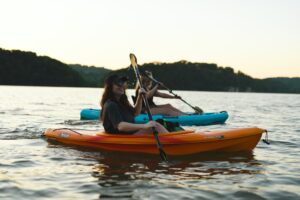






































 Before you can catch more trout in lakes, you need to understand their behavior. Trout are cold-water fish that prefer to stay in water temperatures between 50 and 60 degrees Fahrenheit. They also tend to stay in deeper waters during the warmer months and move to shallower waters in the cooler months. Knowing these behaviors can help you determine the best time of day, season, and weather for lake trout fishing.
Before you can catch more trout in lakes, you need to understand their behavior. Trout are cold-water fish that prefer to stay in water temperatures between 50 and 60 degrees Fahrenheit. They also tend to stay in deeper waters during the warmer months and move to shallower waters in the cooler months. Knowing these behaviors can help you determine the best time of day, season, and weather for lake trout fishing.
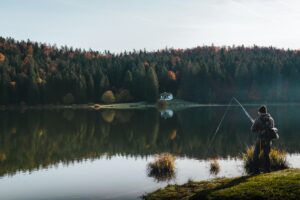 Respect catch limits: Make sure you know the catch limits for the lake you’re fishing in and stick to them. Overfishing can harm fish populations and reduce the quality of the fishery.
Respect catch limits: Make sure you know the catch limits for the lake you’re fishing in and stick to them. Overfishing can harm fish populations and reduce the quality of the fishery.

 Belly boat fishing, also known as float tube fishing, is a type of fishing that involves using a small, inflatable watercraft to float on the surface of a body of water while fishing. Belly boats are typically made of durable materials like PVC, nylon, or rubber and are designed to be lightweight and easy to maneuver.
Belly boat fishing, also known as float tube fishing, is a type of fishing that involves using a small, inflatable watercraft to float on the surface of a body of water while fishing. Belly boats are typically made of durable materials like PVC, nylon, or rubber and are designed to be lightweight and easy to maneuver.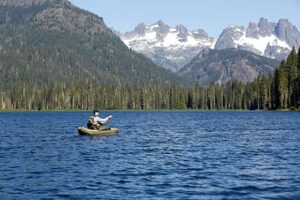 Belly boat fishing is a versatile technique that can be used to catch a wide variety of fish species. Here are a few of the most common fish species to target:
Belly boat fishing is a versatile technique that can be used to catch a wide variety of fish species. Here are a few of the most common fish species to target:















